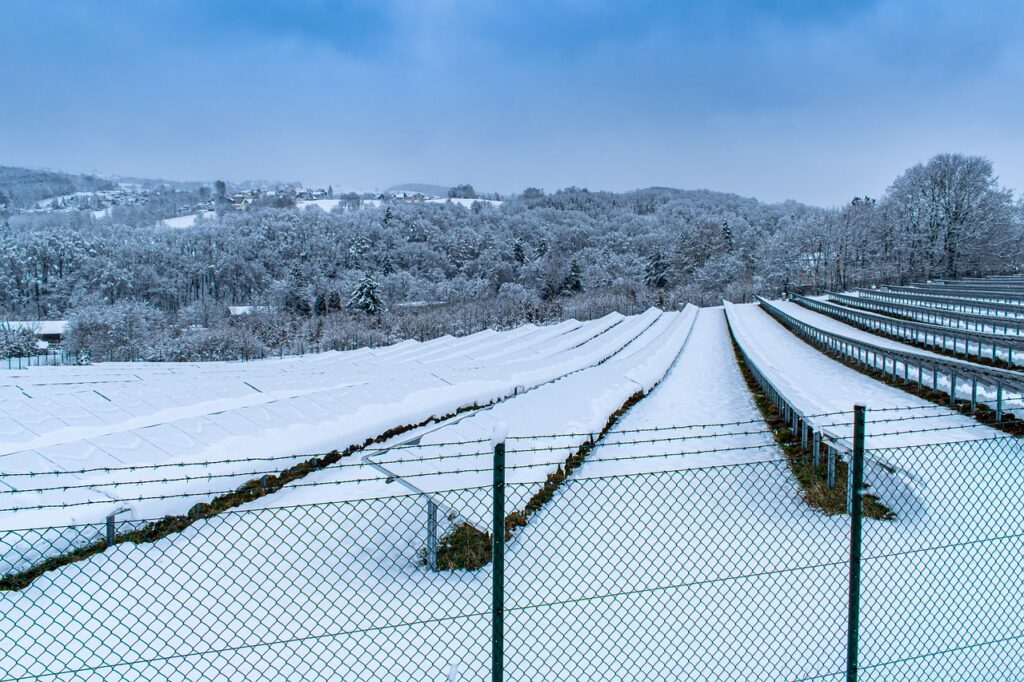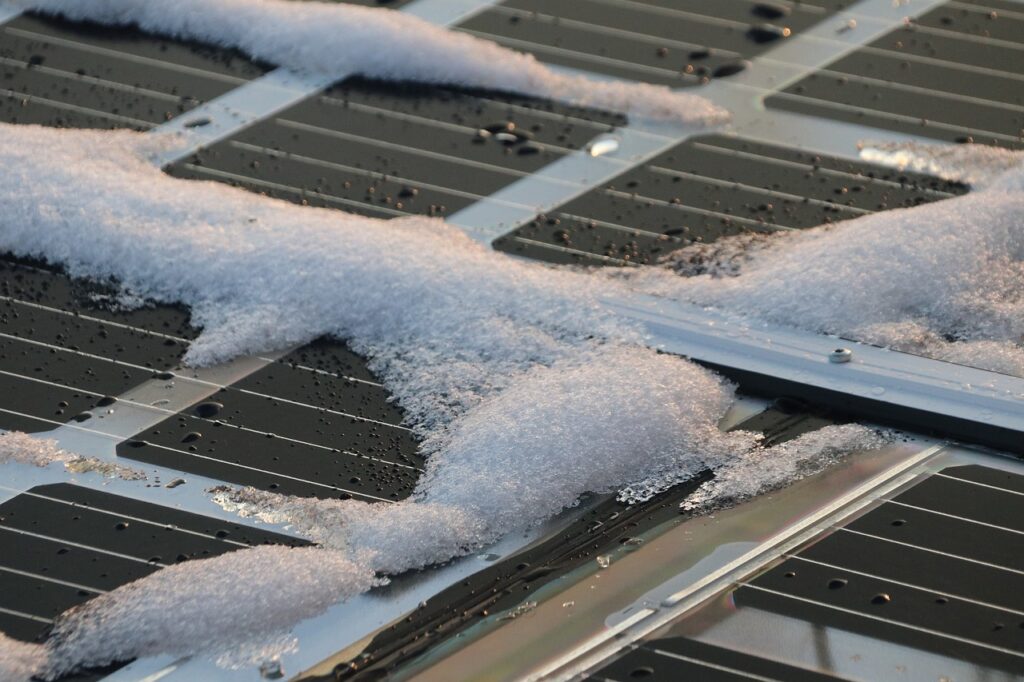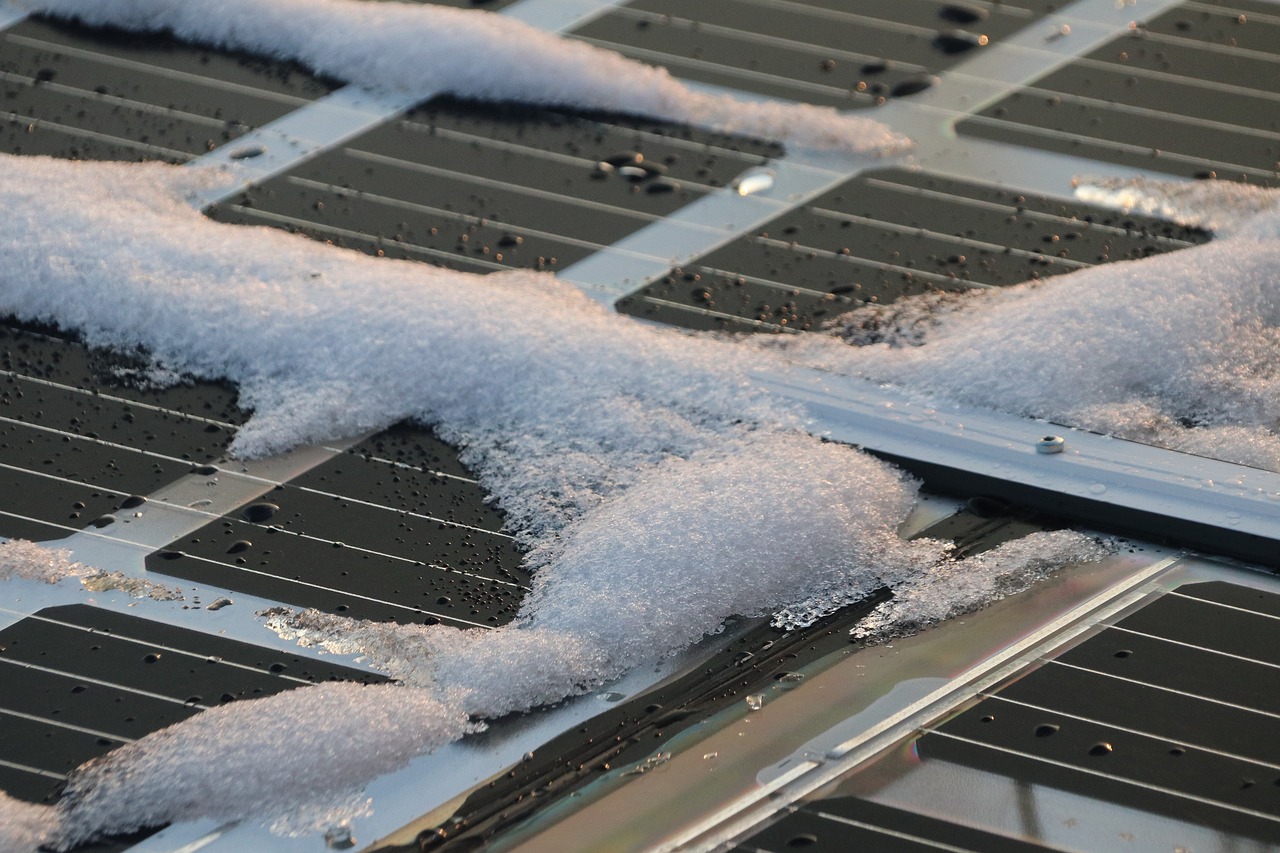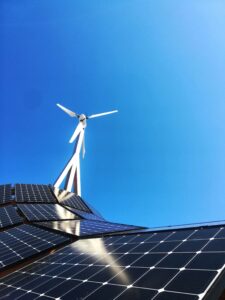Curious about the impact of snow on solar panels? Wonder no more! We are here to shed some light on this intriguing question. When those fluffy white flakes begin to fall, solar panels have a unique response. While the presence of snow does affect their performance, it’s not necessarily a deal-breaker. In this article, we’ll explore what happens to solar panels when it snows and find out how they adapt to the winter wonderland. Get ready to unravel the mysteries of solar energy in snowy conditions!

Effect of Snow on Solar Panels
Reduced Energy Production
When snow accumulates on solar panels, it has a significant impact on their energy production. The layer of snow acts as an insulator, preventing sunlight from reaching the photovoltaic cells. As a result, the panels generate less electricity or may even stop producing power altogether. This reduction in energy production can be frustrating for solar panel owners, especially during the winter months when sunlight is already limited.
Coverage and Obstruction
Snow can also pose a challenge to solar panels by completely covering them. When the panels are buried under a thick layer of snow, they become completely obstructed and are unable to generate any electricity. This can be particularly problematic if the snowfall is heavy and continues for an extended period. In addition to the complete obstruction, snow can also partially cover the panels, reducing their efficiency and further hampering energy production.
Weight and Structural Integrity
Another concern when it snows is the additional weight that accumulates on the solar panels. While solar panels are built to withstand various weather conditions, the weight of the snow can exceed their design limits, putting strain on the structure. This increased weight can cause the panel frames to bend or snap, potentially leading to irreversible damage. Therefore, it is crucial to consider the weight-bearing capacity of the solar panel system and ensure its structural integrity when dealing with snow accumulation.
Preventing Snow Build-up
Tilting the Panels
One effective method to prevent snow build-up on solar panels is to install them at an angle. Tilted panels allow the snow to slide off more easily, reducing the chances of it accumulating and obstructing the sunlight. Additionally, tilting the panels can also help with optimizing their performance by increasing the amount of sunlight they receive, even during shorter winter days.
Installing Panel Heating Systems
Another option to prevent snow build-up is to invest in panel heating systems. These systems use electrical heating elements installed on the surface of the solar panels. When activated, the heating elements raise the temperature of the panels, causing the snow to melt and slide off. While this method can be effective, it does require a power source and may consume additional energy, negating some of the benefits of the solar panels in the first place.
Using Snow Rakes or Brooms
For those who prefer a manual approach, using snow rakes or brooms can help remove snow from solar panels. Care must be taken to avoid damaging the panels while gently clearing the snow. These tools enable users to safely reach the panels from the ground and remove the snow layer by layer. However, this method requires regular monitoring of snow accumulation and prompt action to prevent the snow from freezing or becoming difficult to remove.
Applying Special Coatings
Another preventive measure is to apply special coatings to the surface of the solar panels. These coatings, often hydrophobic in nature, reduce the adherence of snow and ice to the panels. They help to minimize snow build-up and make it easier for snow to slide off when the panels are angled or heated. It is essential to consult with a professional to determine the best coating options for the specific solar panel system.

Operating in Cold Temperatures
Efficiency in Cold Weather
Solar panels generally perform more efficiently in colder temperatures. Cold weather allows the photovoltaic cells to conduct electricity more effectively, resulting in a higher energy yield. However, it is important to note that while efficiency may increase in the cold, the presence of snow can still hinder overall performance. Therefore, finding a balance between the benefits of cold weather and the challenges of snow is vital for optimal energy production.
Eliminating Ice Accumulation
In addition to snow accumulation, the formation of ice on solar panels can also be problematic. Ice can form on the panels when melted snow refreezes due to low temperatures. This ice can block sunlight and hinder energy generation. To eliminate ice accumulation, panel heating systems or specialized ice melting devices can be useful. Alternatively, heating the surrounding area or adjusting the tilt of the panels can help prevent ice formation.
Monitoring System Performance
Regular monitoring of the solar panel system’s performance is crucial, especially during cold weather conditions. Monitoring software or hardware can provide real-time data on energy production, allowing users to identify any issues promptly. By actively monitoring the system, any reductions in energy production due to snow or ice can be detected early, enabling prompt action to be taken to improve performance and minimize energy loss.
Clearing Snow from Solar Panels
Safety Measures
Before attempting to clear snow from solar panels, it is essential to prioritize safety. Ensure that the necessary safety precautions are taken, such as wearing protective gear and avoiding slippery surfaces. If the panels are located on the roof, it may be necessary to enlist the help of professionals to conduct the snow removal safely. Additionally, it is crucial to be cautious about falling snow or ice when clearing panels located above ground level.
Choosing the Right Tools
When it comes to clearing snow from solar panels, choosing the right tools is essential. Soft bristle brushes or snow rakes specifically designed for solar panels are recommended to prevent damage to the panels. Avoid using sharp or metal tools that may scratch or shatter the panels. Additionally, using long-handled tools, or even telescopic poles, can ensure safe and efficient access to the panels.
Gentle Snow Removal Techniques
When removing snow from solar panels, it is crucial to employ gentle techniques that minimize the risk of damage. Start by gently brushing off the snow using a soft brush or snow rake. Begin at the top edge of the panel and work downward, being careful not to apply excessive force or pressure. Avoid using sharp movements that could cause the panels to crack. It is best to clear the snow layer by layer, preventing excessive weight on the panels.

Dealing with Winter Weather Conditions
Optimizing Energy Production
To maximize energy production during winter weather conditions, it is crucial to optimize the solar panel system. Regularly cleaning the panels and ensuring they are free from snow, ice, or debris will help improve their efficiency. Additionally, monitoring the system’s performance, adjusting panel tilt and orientation, and using any available heating methods will contribute to maintaining optimal energy production during winter.
Shifting Energy Usage
Winter weather often brings shorter and cloudier days, resulting in reduced sunlight for solar panels. To compensate for this, it can be beneficial to shift energy usage by implementing time-of-use plans, if available. By utilizing electricity-intensive activities during times of potential peak energy production, such as midday when the sun is at its highest, solar panel owners can maximize the benefits of their systems.
Maintaining a Backup Power Source
In regions with severe winter weather conditions, it is advisable to maintain a backup power source. This ensures a continuous supply of electricity, especially during periods of heavy snowfall or prolonged cloudy days. Backup power sources, such as batteries or diesel generators, can provide power when the solar panels are unable to generate sufficient energy. This backup solution will guarantee uninterrupted electricity supply, providing peace of mind during harsh winter weather.
Warranty and Maintenance
Understanding Manufacturer Policies
Before installing solar panels, it is essential to thoroughly understand the warranty and maintenance policies provided by the manufacturer. Familiarize yourself with any specific guidelines for winter weather conditions and snow-related issues. Manufacturers may have recommendations or requirements for maintenance, snow removal, or warranty coverage during snowy periods. Adhering to their guidelines will help ensure the longevity and performance of the solar panel system.
Regular Maintenance and Cleaning
Regular maintenance and cleaning are essential for the efficient operation of solar panels, regardless of the season. However, during winter, cleaning becomes even more crucial due to the presence of snow and ice. Remove any snow or ice promptly to minimize energy loss and prevent damage to the panels. Additionally, consider scheduling professional inspections and maintenance during winter to address any potential issues promptly.
Inspecting for Damage or Wear
Winter weather conditions can be harsh on solar panels, so it is essential to inspect them for any signs of damage or wear. Check for cracks, scratches, or any abnormal wear and tear that may have occurred due to snow removal efforts or extreme weather. Addressing any damage immediately will help prevent further deterioration and ensure the panels continue to function optimally.
Cost and Environmental Considerations
Calculating Cost Implications
When considering the impact of snow on solar panels, it is essential to factor in the associated costs. The cost implications include the installation of preventive measures, such as panel heating systems or special coatings, as well as potential repair or maintenance costs resulting from snow-related damage. While these costs may vary depending on the specific system and location, they should be carefully evaluated to determine the overall financial feasibility and return on investment of solar panel ownership in areas with heavy snowfall.
Environmental Impact of Snow
Snow can have both positive and negative environmental impacts on solar panels. On one hand, snow acts as an insulator, improving the efficiency of panels by keeping them cooler. Additionally, a fresh layer of snow can reflect sunlight onto the panels, increasing their energy production. However, prolonged and excessive snow accumulation can hinder energy production, leading to a decrease in overall environmental benefits. Balancing the positive and negative effects of snow on solar panels is crucial for maximizing their environmental impact.
Long-Term Benefits and Investments
Despite the challenges posed by snow, solar panels continue to provide a cost-effective and environmentally friendly source of energy year-round. While winter weather conditions can temporarily reduce their efficiency, the long-term benefits and investments associated with solar panels often outweigh these challenges. By understanding and implementing preventive measures and proper maintenance techniques, solar panel owners can ensure consistent energy production and contribute to a sustainable future, even in snowy conditions.
In conclusion, snow can have a significant effect on solar panels, reducing energy production, obstructing coverage, and impacting structural integrity. However, preventive measures such as tilting the panels, installing heating systems, using snow rakes or brooms, and applying special coatings can help minimize snow build-up. In cold temperatures, solar panels can still operate efficiently, but it is important to eliminate ice accumulation and regularly monitor system performance. When clearing snow from solar panels, safety measures, the right tools, and gentle removal techniques should be prioritized. Dealing with winter weather conditions involves optimizing energy production, shifting energy usage, and maintaining a backup power source. Understanding warranty and maintenance policies, conducting regular inspections and cleaning, and evaluating cost and environmental considerations are also crucial. Despite the challenges, solar panels remain a worthy long-term investment that can provide clean and sustainable energy, even in snowy conditions.




